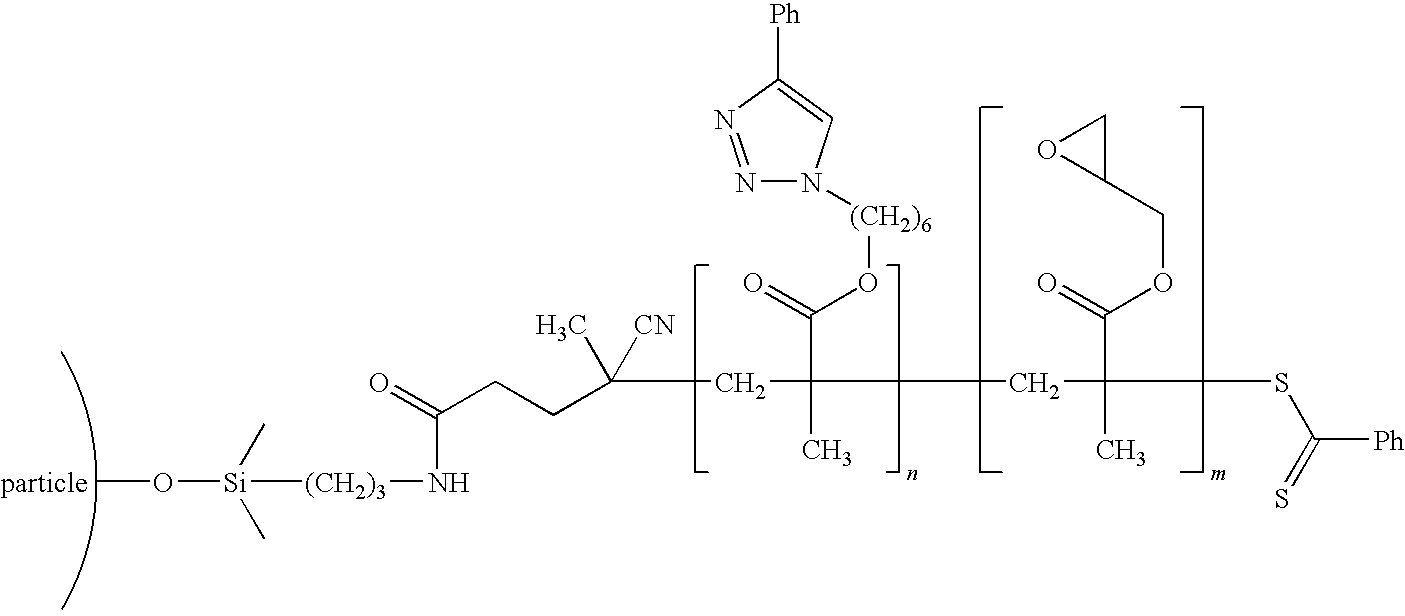Diblock copolymer modified nanoparticle/polymer composites
a nanoparticle and polymer technology, applied in the field of nanoparticles, can solve the problems of reducing the ductility and opacity of epoxy, and the stiffness of epoxy
- Summary
- Abstract
- Description
- Claims
- Application Information
AI Technical Summary
Benefits of technology
Problems solved by technology
Method used
Image
Examples
example 1
[0046]In this example, reversible addition-fragmentation chain transfer (RAFT) polymerization combined with click chemistry was used to graft polymers on SiO2 nanoparticles (ORGANOSILICASOL™ colloidal silica in Methyl isobutyl ketone (MIBK) from Nissan Chemical). 4-Cyanopentanoic acid dithiobenzoate (CPDB) served as the RAFT reaction agent.
[0047]The nanoparticles were modified using a living free radical polymerization method and a click chemistry functionalization method to create a electrically conducting inner block (molecular weight 9.8 Kg / mole) and an outer block with polystyrene compatible groups (molecular weight 25 Kg / mole), and a graft density of 0.05 chains / nm2. An example chemistry is shown in the schematic below:
Synthesis of 6-Azidohexyl Methacrylate (AHMA)
[0048]A solution of 1-azido-6-hydroxyhexane (14.3 g, 100 mmol), methacrylic acid (7.74 g, 90 mmol), and 4-dimethylaminopyridine (DMAP) (3.67 g, 30 mmol) in 100 mL of methylene chloride was cooled to 0° C. in a 500 mL r...
example 2
[0053]In this example, reversible addition-fragmentation chain transfer (RAFT) polymerization combined with click chemistry was used to graft polymers on SiO2 nanoparticles (ORGANOSILICASOL™ colloidal silica in Methyl isobutyl ketone (MIBK) from Nissan Chemical). 4-Cyanopentanoic acid dithiobenzoate (CPDB) served as the RAFT reaction agent.
[0054]The nanoparticles were modified using a living free radical polymerization method and a click chemistry functionalization method to create a electrically conducting inner block (molecular weight 9.8 Kg / mole) and an outer block with polydimethyl siloxane compatible groups (molecular weight 150 Kg / mole), and a graft density of 0.21 chains / nm2. An example chemistry is shown in the schematic below:
Synthesis of 6-Azidohexyl Methacrylate (AHMA)
[0055]A solution of 1-azido-6-hydroxyhexane (14.3 g, 100 mmol), methacrylic acid (7.74 g, 90 mmol), and 4-dimethylaminopyridine (DMAP) (3.67 g, 30 mmol) in 100 mL of methylene chloride was cooled to 0° C. in...
example 3
Preparation of Polymer-Coated Silica Nanoparticles
[0060]In this example, reversible addition-fragmentation chain transfer (RAFT) polymerization was used to graft polymers on SiO2 nanoparticles (ORGANOSILICASOL™ colloidal silica in Methyl isobutyl ketone (MIBK) from Nissan Chemical). 4-Cyanopentanoic acid dithiobenzoate (CPDB) served as the RAFT reaction agent.
[0061]The nanoparticles were modified using a living free radical polymerization method to create a rubbery inner block (molecular weight 10 Kg / mole) and an outer block with epoxy compatible groups (molecular weight 65 Kg / mole), and a graft density of 0.2 chains / nm2. An example chemistry is shown in the schematic below:
Synthesis of 4-Cyanopentanoic Acid Dithiobenzoate (CPDB)
[0062]Twenty milliliters (ml) of phenyl magnesium bromide (3 M solution in ethyl ether) was added to a 250-mL, round-bottom flask, the phenyl magnesium bromide which was diluted to 100 mL with anhydrous tetrahydrofuran (THF). Carbon disulfide (4.6 g) was add...
PUM
| Property | Measurement | Unit |
|---|---|---|
| Diameter | aaaaa | aaaaa |
| Fraction | aaaaa | aaaaa |
| Fraction | aaaaa | aaaaa |
Abstract
Description
Claims
Application Information
 Login to View More
Login to View More - R&D
- Intellectual Property
- Life Sciences
- Materials
- Tech Scout
- Unparalleled Data Quality
- Higher Quality Content
- 60% Fewer Hallucinations
Browse by: Latest US Patents, China's latest patents, Technical Efficacy Thesaurus, Application Domain, Technology Topic, Popular Technical Reports.
© 2025 PatSnap. All rights reserved.Legal|Privacy policy|Modern Slavery Act Transparency Statement|Sitemap|About US| Contact US: help@patsnap.com



